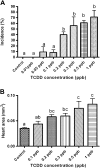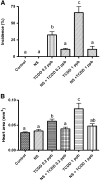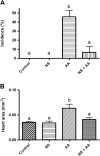TCDD induced pericardial edema and relative COX-2 expression in medaka (Oryzias Latipes) embryos
- PMID: 20801906
- PMCID: PMC2955216
- DOI: 10.1093/toxsci/kfq254
TCDD induced pericardial edema and relative COX-2 expression in medaka (Oryzias Latipes) embryos
Abstract
Exposure to dioxin and other aryl hydrocarbon receptor (AhR) ligands results in multiple, specific developmental cardiovascular phenotypes including pericardial edema and circulatory failure in small aquarium fish models. Although phenotypes are well described, mechanistic underpinnings for such toxicities remain elusive. Here we suggest that AhR activation results in stimulation of inflammation and "eicosanoid" pathways, which contribute to the observed developmental, cardiovascular phenotypes. We demonstrate that medaka embryos exposed to 2,3,7,8-tetrachlorodibenzo-p-dioxin (TCDD) (0.05-1 ppb) during early development result in a dose-related increase in the prevalence of pericardial edema and that this phenotype correlates with an increase in cyclooxygenase-2 (COX-2) gene expression. Those individuals exhibiting the edema phenotype had significantly greater COX-2 mRNA than their nonedematous cohort. Selective pharmacological inhibition of COX-2, with NS-398, and genetic knock down of COX-2 with a translation initiation morpholino significantly attenuated prevalence and severity of edema phenotype. Subsequently, exposures of medaka embryos to arachidonic acid (AA) resulted in recapitulation of the pericardial edema phenotype and significantly increased COX-2 expression only in those individuals exhibiting the edema phenotype compared with their nonedematous cohort. AA exposure does not result in significant induction of cytochrome P450 1A expression, suggesting that pericardial edema can be induced independent of AhR/aryl hydrocarbon receptor nuclear translocator/dioxin response element interactions. Results from this study demonstrate that developmental exposure to TCDD results in an induction of inflammatory mediators including COX-2, which contribute to the onset, and progression of heart dysmorphogenesis in the medaka model.
Figures









Similar articles
-
CYP1A/regucalcin gene expression and edema formation in zebrafish embryos exposed to 2,3,7,8-Tetrachlorodibenzo-p-dioxin.Bull Environ Contam Toxicol. 2008 Jun;80(6):482-6. doi: 10.1007/s00128-008-9395-8. Epub 2008 May 10. Bull Environ Contam Toxicol. 2008. PMID: 18470470
-
2,3,7,8-Tetrachlorodibenzo-p-dioxin activation of the aryl hydrocarbon receptor/aryl hydrocarbon receptor nuclear translocator pathway causes developmental toxicity through a CYP1A-independent mechanism in zebrafish.Mol Pharmacol. 2004 Sep;66(3):512-21. doi: 10.1124/mol.66.3.. Mol Pharmacol. 2004. PMID: 15322242
-
Induction of cytochrome P450 1A is required for circulation failure and edema by 2,3,7,8-tetrachlorodibenzo-p-dioxin in zebrafish.Biochem Biophys Res Commun. 2003 May 2;304(2):223-8. doi: 10.1016/s0006-291x(03)00576-x. Biochem Biophys Res Commun. 2003. PMID: 12711302
-
Aryl hydrocarbon receptor 2 mediates 2,3,7,8-tetrachlorodibenzo-p-dioxin developmental toxicity in zebrafish.Toxicol Sci. 2003 Nov;76(1):138-50. doi: 10.1093/toxsci/kfg202. Epub 2003 Jul 25. Toxicol Sci. 2003. PMID: 12883077
-
Understanding dioxin developmental toxicity using the zebrafish model.Birth Defects Res A Clin Mol Teratol. 2006 Jan;76(1):7-18. doi: 10.1002/bdra.20216. Birth Defects Res A Clin Mol Teratol. 2006. PMID: 16333842 Review.
Cited by
-
Effect-directed analysis of Elizabeth River porewater: developmental toxicity in zebrafish (Danio rerio).Environ Toxicol Chem. 2014 Dec;33(12):2767-74. doi: 10.1002/etc.2738. Environ Toxicol Chem. 2014. PMID: 25196082 Free PMC article.
-
Molecular targets that link dioxin exposure to toxicity phenotypes.J Steroid Biochem Mol Biol. 2011 Oct;127(1-2):96-101. doi: 10.1016/j.jsbmb.2010.12.005. Epub 2010 Dec 17. J Steroid Biochem Mol Biol. 2011. PMID: 21168493 Free PMC article. Review.
-
Developmental Toxicity of Fine Particulate Matter: Multifaceted Exploration from Epidemiological and Laboratory Perspectives.Toxics. 2024 Apr 6;12(4):274. doi: 10.3390/toxics12040274. Toxics. 2024. PMID: 38668497 Free PMC article. Review.
-
From the Cover: Embryonic Exposure to TCDD Impacts Osteogenesis of the Axial Skeleton in Japanese medaka, Oryzias latipes.Toxicol Sci. 2017 Feb;155(2):485-496. doi: 10.1093/toxsci/kfw229. Epub 2016 Nov 15. Toxicol Sci. 2017. PMID: 28077779 Free PMC article.
-
A comparative study on targeted gene expression in zebrafish and its gill cell line exposed to chlorpyrifos.In Vitro Cell Dev Biol Anim. 2024 Apr;60(4):397-410. doi: 10.1007/s11626-024-00892-5. Epub 2024 Apr 8. In Vitro Cell Dev Biol Anim. 2024. PMID: 38589735
References
-
- Antkiewicz DS, Burns CG, Carney SA, Peterson RE, Heideman W. Heart malformation is an early response to TCDD in embryonic zebrafish. Toxicol. Sci. 2005;84:368–377. - PubMed
-
- Antkiewicz DS, Peterson RE, Heideman W. Blocking expression of AHR2 and ARNT1 in zebrafish larvae protects against cardiac toxicity of 2,3,7,8-tetrachlorodibenzo-p-dioxin. Toxicol. Sci. 2006;94:175–182. - PubMed
-
- Arzuaga X, Reiterer G, Majkova Z, Kilgore MW, Toborek M, Hennig B. PPARalpha ligands reduce PCB-induced endothelial activation: possible interactions in inflammation and atherosclerosis. Cardiovasc. Toxicol. 2007;7:264–272. - PubMed
Publication types
MeSH terms
Substances
Grants and funding
LinkOut - more resources
Full Text Sources
Medical
Research Materials
Miscellaneous

